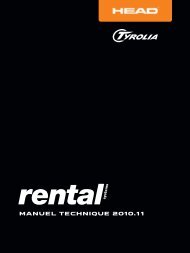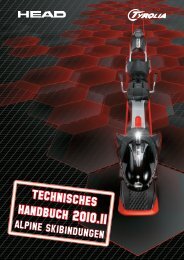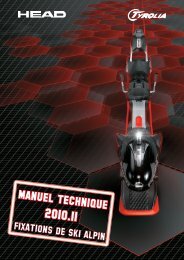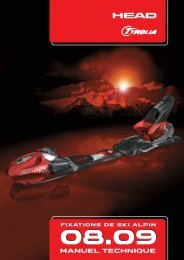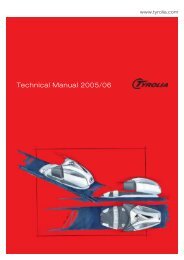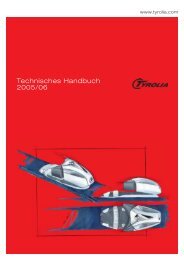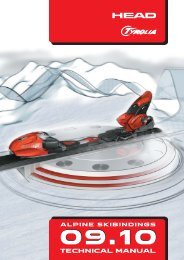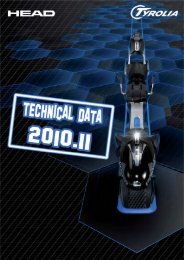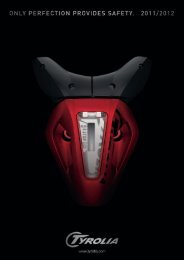You also want an ePaper? Increase the reach of your titles
YUMPU automatically turns print PDFs into web optimized ePapers that Google loves.
15. If many bindings fail, check the test device<br />
and re-inspect the Reference Boot.<br />
If necessary, select another boot and retest<br />
the bindings.<br />
F<br />
Skier Code<br />
Binding<br />
Type<br />
Children<br />
Sole<br />
length<br />
mm<br />
Release<br />
Indicator<br />
J Junior 306 mm 4.5 45 Nm 175 Nm<br />
L Adult 327 mm 6.0 60 Nm 239 Nm 51–69 Nm 203–275 Nm<br />
Preseason Boot Preparation<br />
The procedure that follows is an integral part of<br />
preseason maintenance.<br />
1. Clean all boots with a mild detergent and water,<br />
and repair or replace damaged or missing<br />
parts.<br />
2. Visually check:<br />
a.) Conformance with ISO and other applicable<br />
standards- ISO 5355. If the boot contacts<br />
the binding, brake, or AFD in areas other<br />
than the designated contact points, it may<br />
be incompatible with the binding.<br />
b.) Boot material. If the sole at the contact<br />
points with the binding or AFD can be<br />
scratched with a finger nail, the boot may<br />
be of inferiors quality and incompatible<br />
with the binding.<br />
c.) Boot sole condition. If the boot sole is<br />
damaged, worn, or contaminated at<br />
contact points with the binding or AFD in<br />
a manner which can not be corrected, the<br />
boot may be incompatible with the binding,<br />
“Verify boot sole dimensions” on page 48.<br />
d.) Brake compatibility with sole.<br />
e.) Rubber and/or metal sole protectors.<br />
If such materials contact the binding or<br />
AFD the boot may be incompatible with<br />
the binding.<br />
f.) Mold flashings. Flashing which can be.seen<br />
or felt at contact points with the binding,<br />
brake, or AFD must be carefully removed.<br />
3. Remove from inventory all boots that have<br />
failed the visual check.<br />
Preseason Boot Sampling<br />
Altough sampling eliminates the need to test every<br />
boot before the season starts, the sample chosen<br />
must be representative of the inventory.<br />
1. For boots that are new to inventory or have 1.<br />
never been inspected, take a single boot from<br />
each cell (a cell is all boots of the same make,<br />
model, year, and shell size).<br />
Setting<br />
Reference<br />
Torque<br />
▲<br />
Twist Nm<br />
Reference<br />
Torque<br />
Forward Nm<br />
CONTENTS<br />
Twist<br />
Inspection<br />
Range Nm<br />
270mm 2.5 25 Nm 94 Nm 21–29 Nm<br />
80–108 Nm 17.5–33 Nm<br />
38–52 Nm 149–201 Nm<br />
Table [A] Preseason Binding Inspection<br />
2. For used boots, take a 5% (but not less than<br />
16 or more than 80) random sample of the<br />
entire inventory, see Table [B]. Make sure<br />
that there is at least one boot from each cell<br />
in the sample.<br />
Preseason Boot Inspection<br />
RENTAL/ 45<br />
The procedure that follows helps to assure boot/<br />
binding compatibility and boot interchange ability.<br />
Note: when using Table [A], in the Boot Inspection<br />
procedures that follow, the Sole Lenght and release<br />
Indicator Setting columns should be ignored.<br />
1. Randomly select a pair of bindings that have<br />
passed the preseason inspection from each<br />
binding type; adult, junior, child.<br />
2. Lubricate all boot/binding contact points with<br />
a mild liquid detergent.<br />
3. Without regard to wheter the boot is new or<br />
used, sort the sample by sole type and length<br />
according to the 20 mm Sole Length Categories<br />
defined by the Release/Retention<br />
Adjustment Chart.<br />
4. In each Sole Lenght Category rank the boots<br />
by sole length and select the middle boot.<br />
5. In each Sole Lenght Category fit the appropriate<br />
reference bindings to this “typical” boot<br />
and adjust the two bindings to release as<br />
close as practical to the Reference Torque in<br />
Table [A]. Use the Reference Torque corresponding<br />
to Skier Code [L] for the6 Adult<br />
binding, [J] for Junior binding, and [E] for the<br />
Child binding.<br />
6. Rinse the lubricant from one binding and<br />
mark it “clean”. Mark the other “lubricated”.<br />
7. Test each boot in the Sole Length Category<br />
with the clean Reference Binding and then<br />
the lubriceted Reference Binding in both twist<br />
and forward lean (only one direction in twist is<br />
required for the clean binding).<br />
8. Set aside any boots for which the lubricated<br />
Test Result is more than 20% less than the<br />
clean Test Result in the same direction of<br />
release or the lubricated Test Result in any<br />
▲<br />
Forward<br />
Inspection<br />
Range Nm<br />
Twist In-<br />
Use Range<br />
31–59 Nm<br />
42–78 Nm<br />
Forward In-<br />
Use Range<br />
Nm<br />
66–122Nm<br />
122–228 Nm<br />
167–311 Nm



